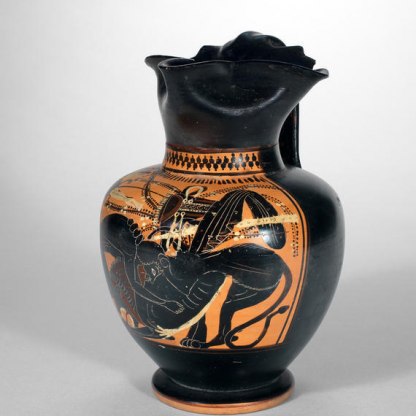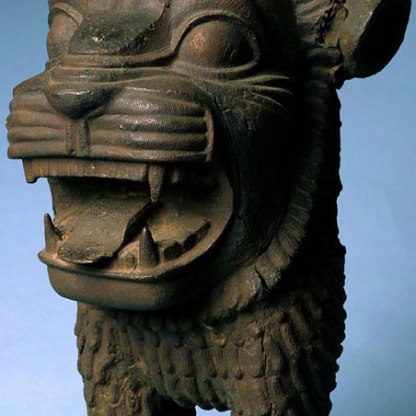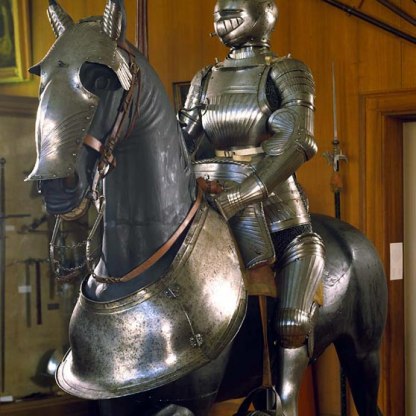Parade Burgonet

By these things to the stars...
These proud words are inscribed, in Greek, on the pages of a book depicted on the comb of this parade helmet. Below the book a figure of Victory holds up a laurel wreath. On the other side another female half-figure – the personification of Fame – blows a trumpet. Various other objects are displayed on the comb like trophies: musical instruments, urns, cannon, weapons, armour. Every decorative aspect of the helmet proclaims the confidence and grandeur of its wearer. It is all the more ironic, then, that it first came to light in England at a sale of 'theatrical junk' in 1935.
Perhaps it was the corroded state, the rather dour monochrome, that led to its being so carelessly dismissed back then. It would originally have looked much more splendid. Judging from its style and quality, it is a product of the celebrated siteenth-century armour workshop run by the Milanese brothers, Filippo and Francesco Negroli. A similar helmet in Vienna gives us an idea of what it might once have looked like. Here much of the subsidiary decoration – the designs on the comb and the diadem, the whiskers and eyebrows on the lion-face visor – are picked out with gold, traces of which can still be seen on various parts of the Fitzwilliam helmet.
A burgonet is a lightweight helmet usually used by cavalry – the word derives from the area of Burgundy in France where it was first developed. This lavish example, however, could never have felt the heat of battle. The stern leonine face on the 'visor' might well have instilled fear into an enemy, but would have been quite impossible to see through.
Elaborate pieces like this are described as all'antica Romana – in the antique Roman style – and were popular with princes and kings in the Renaissance, who sought to associate themselves with the mythical and historical warriors of the ancient world. A sixteenth-century maiolica plate in the Fitzwilliam [Mar.C.63-1927], is unusual for showing a woman wearing an elaborate antique-style helmet.
The lion's face on the visor alludes to an adventure of the ancient hero Hercules (Herakles to the Greeks). Having throttled the ferocious lion of Nemea as the first of his twelve labours, he thereafter wore its impregnable pelt as armour, the lion's head protecting his own. This great exploit is shown on a fifth-century BCE Athenian black figure vase in the Fitzwilliam, left [GR.7.1937]. The hero's divine protectress Athena stands by as he wrestles the monstrous cat.
Since at least the sixth century BCE, political leaders had sought to identify themselves with Hercules – a byword for strength and courage. The coin illustrated on the left [SNG.4.2180] was issued during the reign of Alexander the Great, who conquered Greece and much of the known world in the late fourth century BCE. It depicts Hercules wearing his lion skin – and looking very much like the young Macedonian King.
Renaissance rulers followed this ancient trend. The Holy Roman Emperor Maximilian, for example, dubbed himself Hercules Germanicus – the German Hercules – and had himself portrayed as the hero. It has been suggested that this particular helmet was made for Archduke Ferdinand of Austria, who reigned from 1529 to 1595.
Junk it may not be. Theatrical, though, it certainly is – the centrepiece of a very upmarket dressing-up box.
Themes and periods
Data from our collections database
Burgonet, for parade use, with embossed, chased and counterfeit-damascend classical decoration. Formed of a one-piece skull with a pivoted 'visor', an incomplete pair of cheek-pieces, and a neck-defence of one lame. The skull has a high, medial comb, extending from the brow to the nape. The crest of the comb is decorated to either side with acanthus leaves, embossed and chased in low relief. Each side of the comb is decorated between raised ribs with a panel of trophies including arms and armour, musical instruments, a ewer, a basin and a mask, all embossed and chased in relief, and retaining traces of counterfeit-damascened gold ornament. The panel on the right side includes an open book, counterfeit-damascened with the Greek inscription (By these things to the stars). Each side of the skull is decorated with a central winged, nude, female demi-figure with a skirt of acanthus from which a pair of adorsed acanthus volutes terminating in flowerheads issue, all embossed and chased in high relief. The figure on the right side represents Fame, and the figure on the left side, Victory. The skull is decorated around the nape with a rounded rib, divided into short sections by numerous transverse grooves and superimposed on a broader, flat rib. The lower edge of the skull is cut away at the front to form a shallow, arched face-opening. Each side of the face-opening is pierced with a rivet-hole for the attachment of a missing brow-plate. The lower edge of the skull has a shallow, concave cut-out at each side to accommodate the cheek-pieces. The apex of each cut-out is itself cut with a shallow, rectangular notch to accommodate the internal hinge of the cheek-piece. The hinge is lobed around each of the pair of rivets that secure it to skull and cheek-piece respectively. The rivets that secure it to the skull are externally flush and of iron. The rear one on the right side is missing. The rivets that secure the hinge to the cheek-piece are round-headed and of brass. Each cheek-piece has a convex upper edge, matching the profile of the cut-out at the side of the skull, which it overlaps. The rear edge of the cheek-piece is decorated with a short continuation of the embossed rib that runs around the nape of the skull. The cheek-piece is pierced just in front of the rib with four circular ventilation-holes arranged in a lozenge-formation around a further such hole. The lower front corner of the cheek-piece is cut away in a concave curve with a roped inward turn accompanied by a recessed border. The straight lower edge of the cheek-piece is bordered by five round-headed brass rivets, arranged as a row of three with one located below each of the outer ones. Both of the lower rivets are now missing on the right cheek-piece, and both of the front ones on the left. Some or all of these rivets originally served to secure the missing lower extension-plates of the cheek-pieces which probably met and were fastened together at the chin. The lower edge of the skull is cusped and flanged outwards at the centre of the nape, and lobed to either side of it to receive the modern, round-headed, brass rivets with circular, internal washers that attach the overlapping neck-defence. Later holes for three further rivets at either side are pierced in both the lower edge of the skull and the upper edge of the neck-defence. All are now vacant except for the inner one on the left side which is occupied by a round-headed brass rivet that has, however, broken out of the hole in the skull. The central cusp of the lower edge of the skull, which is split and bent, is pierced with three rivet-holes of which the left one is occupied by an externally-flush rivet of iron. The neck-defence of one plate curls outwards at its lower edge which is obtusely pointed at its centre. The point is pierced with a later hole that has broken out to the edge. The edge is pierced to either side of this hole with a pair of later smaller holes, possibly for wiring purposes. The neck-defence is decorated at its upper edge with a series of scallops emphasised by pairs of punched crescents, and below them with deep longtitudinal gadroons interrupted at the centre by acanthus leaves all embossed and chased in relief. Attached by modern pivots at either side of the skull, just behind the hinges for the cheek-pieces, is a one-piece 'visor'. The pivots take the form of brass-capped, round-headed iron rivets with octagonal, internal washers. Pierced in both the skull and the 'visor' just in front of the left pivot is a further hole which may at one time have served as a pivot-point. The hole in the 'visor' is plugged with an externally-flush rivet, while that in the skull remains vacant. The hole in the 'visor' for the right pivot has broken out and been repaired with an internal patch secured by two iron rivets. The 'visor' is decorated with a lion's mask beneath an approximation of a gladiator's visor, in both cases embossed and chased in high relief. The 'gladiator's visor' is of prow-shaped form with a bold, inward, partial turn at its upper edge, divided into short sections by numerous transverse grooves and scrolled at its ends. Its lower edge is bordered by a rounded rib likewise divided into short sections by transverse grooves and superimposed on a broader, flat rib which is bordered at its lower edge by a series of scallops emphasised by pairs of punched crescents. The intervening space is filled with upward-directed, vertical gadroons interrupted at the centre by acanthus leaves. The centre of the 'gladiator's visor' is pierced top and bottom with a pair of later holes. The lower pair are occupied by modern, round-headed, brass rivets. A hole at the centre of the brow of the lion's mask is occupied by a smaller, modern, round-headed iron rivet. The elaborately-shaped lateral and lower edges of the 'visor' are flanged inwards.
The helmet was acquired about 1935 by a dealer called Jones at an auction sale of 'theatrical junk', and taken to Sir James Mann for identification. In 1936 it was sold by Foster's Sale Room of Pall Mall, London, to Captain R. P. Johns who in 1937, after some six months, sold it for £200 to Mr John Hunt from whom it was acquired by the Fitzwilliam Museum in the following year. According to a statement published by Charles R. Beard in 1945, the helmet had 'been in England for the better part of a century'. Francis H. Cripps-Day claimed that it had come from the collection of the 1st Lord Amherst of Hackney (1835-1909). It did not, however, appear as part of the Amherst Collection sold by Christie's, London, 11 December 1908.
Legal notes
Given by the Friends of the Fitzwilliam Museum with a contribution from the National Art Collections Fund
Acquisition and important dates
- Method of acquisition: Given
- Dates: 1938-07-13
Dating
The cheek-pieces must be recognised as old replacements since the quality of their workmanship does not match that of the other elements of the helmet. The 'visor' must originally have been fixed in the raised position since it lacks the apertures for vision that would have been essential if it had been fixed in the lowered position as it now is.
The helmet has a russet colour with traces of gold counterfeit damascening on the comb.
The present piece closely resembles a burgonet formerly in the armoury of the Archduke Ferdinand II of Tirol at Schloss Ambras and now in the Hof jagdt- und Rüstkammer, Vienna (Inv. No. A693), which is attributed to Filippo Negroli of Milan and has, since about 1565, been associated with a circular shield bearing, among other inscriptions, the Greek motto (To the stars through these). It also bears an abbreviated Latin text which is interpreted as indicating that the helmet and shield were made for the Emperor Charles V to commemorate his second campaign against the Turks in Algeria in 1541 (Ortwin Gamber & Mattheus Pfaffenbichler, Leibrustkammer II, 1990, pp.45-7, pl.13). An incomplete burgonet of a very similar design is preserved in the Metropolitan Museum of Art, New York (Acc. No. 04.3.223). A burgonet in the same collection (Acc. No. 17.190.1720), signed by Filippo Negroli and dated 1543, is of a different form to the present example, but shows very similar decoration. For discussions and illustrations of the work of the Negroli family, see B. Thomas & O. Gamber, 'L'Arte dell'Armatura', Storia di Milano, Vol. XI, Milan, n.d. [1958], pp. 697-841; and L.G. Boccia & E.T. Coehlo, L'Arte dell'Armatura in Italia, Milan, 1967.
Maker(s)
- Perhaps Negroli, Filippo Armourer
Note
The cheek-pieces must be recognised as old replacements since the quality of their workmanship does not match that of the other elements of the helmet. The 'visor' must originally have been fixed in the raised position since it lacks the apertures for vision that would have been essential if it had been fixed in the lowered position as it now is.
The helmet has a russet colour with traces of gold counterfeit damascening on the comb.
The present piece closely resembles a burgonet formerly in the armoury of the Archduke Ferdinand II of Tirol at Schloss Ambras and now in the Hof jagdt- und Rüstkammer, Vienna (Inv. No. A693), which is attributed to Filippo Negroli of Milan and has, since about 1565, been associated with a circular shield bearing, among other inscriptions, the Greek motto (To the stars through these). It also bears an abbreviated Latin text which is interpreted as indicating that the helmet and shield were made for the Emperor Charles V to commemorate his second campaign against the Turks in Algeria in 1541 (Ortwin Gamber & Mattheus Pfaffenbichler, Leibrustkammer II, 1990, pp.45-7, pl.13). An incomplete burgonet of a very similar design is preserved in the Metropolitan Museum of Art, New York (Acc. No. 04.3.223). A burgonet in the same collection (Acc. No. 17.190.1720), signed by Filippo Negroli and dated 1543, is of a different form to the present example, but shows very similar decoration. For discussions and illustrations of the work of the Negroli family, see B. Thomas & O. Gamber, 'L'Arte dell'Armatura', Storia di Milano, Vol. XI, Milan, n.d. [1958], pp. 697-841; and L.G. Boccia & E.T. Coehlo, L'Arte dell'Armatura in Italia, Milan, 1967.
Place(s) associated
- Milan
Stories, Contexts and Themes
Other highlight objects you might like
Suggested Curating Cambridge products
Sign up to our emails
Be the first to hear about our news, exhibitions, events and more…






